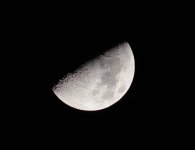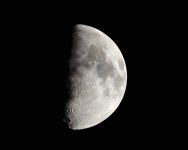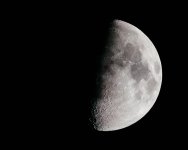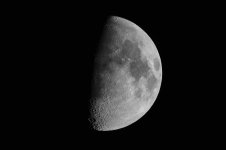You are using an out of date browser. It may not display this or other websites correctly.
You should upgrade or use an alternative browser.
You should upgrade or use an alternative browser.
Post your Moon Shots
- Thread starter Browncoat
- Start date
The same moon as @Marilynne shot only on the west coast at 4:30ish am, 300mm.
View attachment 376836
Yours look a whole lot better than mine Roy!
Clovishound
Senior Member
Re: Moon HDR
Thought I'd give it a try with the new lens.

Thought I'd give it a try with the new lens.
Clovishound
Senior Member
Ok, ya'll have me hooked on moon shots. Problem is, it's difficult to do something different. I managed to do that to a small degree with the previous post. The thin clouds made for some additional interest in the image. The best of the shots was a little overexposed. Thought I work to correct that with this one. It's not bad. The moon itself is better exposed and looks more natural, but it lacks the interest the clouds provided. I do like the phases that have a terminator, as I find the shadows are a compelling feature for me.
Wish I had a longer lens for this. I cropped it pretty severely, and ran it through enhance to get this. I may try this lens on a crop sensor camera and see if the additional magnification, with a similar MP rating will help. Perhaps it will, perhaps not.

This is the same scene shot with a little more exposure and processed to retain some of the blue sky. It was shot near sunset, when the sky was still blue. The moon does not have as much detail in it, not sure why. Perhaps because the original was a little overexposed. Perhaps I missed something in post processing. Perhaps the longer shutter speed introduced some vibration. The later is the most likely. I could probably process the first picture to preserve the blue sky and still have more detail.

Wish I had a longer lens for this. I cropped it pretty severely, and ran it through enhance to get this. I may try this lens on a crop sensor camera and see if the additional magnification, with a similar MP rating will help. Perhaps it will, perhaps not.
This is the same scene shot with a little more exposure and processed to retain some of the blue sky. It was shot near sunset, when the sky was still blue. The moon does not have as much detail in it, not sure why. Perhaps because the original was a little overexposed. Perhaps I missed something in post processing. Perhaps the longer shutter speed introduced some vibration. The later is the most likely. I could probably process the first picture to preserve the blue sky and still have more detail.
blackstar
Senior Member
The same moon as @Marilynne shot only on the west coast at 4:30ish am, 300mm.
View attachment 376836
I wonder if you guys using good Z body that performs excellently in low light ever shoot moon by AF with comparable (or even superior) sharp images?
Clovishound
Senior Member
Mine were shot with a Z5. The Z6 should be even better in low light than mine. The AF works fine for me. not sure how much focus is a major factor with moon shots. An F stop or two down and depth of field should take care of any minor discrepancies. I shoot mine with a small AF area. As long as the little red box is somewhere on the moon, it grabs focus well.
Biggest problems I have are camera shake and having to crop so heavily. I need to get serious and set up my tripod very securely, and use remote control to trip the shutter. Bringing my ASA setting down to minimum would help, as well. Usually, I just pop outside and take a couple quick snaps before the mosquitos make off with my camera. I also need to plan ahead and have my camera in a warm location. It's humid enough in the late evening/early night that the glass fogs up pretty badly going from A/C to outside. That big piece of glass on the front has a lot of thermal mass, and takes quite a while to warm enough to stop fogging up.
Biggest problems I have are camera shake and having to crop so heavily. I need to get serious and set up my tripod very securely, and use remote control to trip the shutter. Bringing my ASA setting down to minimum would help, as well. Usually, I just pop outside and take a couple quick snaps before the mosquitos make off with my camera. I also need to plan ahead and have my camera in a warm location. It's humid enough in the late evening/early night that the glass fogs up pretty badly going from A/C to outside. That big piece of glass on the front has a lot of thermal mass, and takes quite a while to warm enough to stop fogging up.
Clovishound
Senior Member
Re: Moon HDR
Went out and shot a couple with the D3400. Hard to tell whether they have more detail than the full frame images. My gut feeling is that they are.

AF on the D3400 worked just fine as well.
Went out and shot a couple with the D3400. Hard to tell whether they have more detail than the full frame images. My gut feeling is that they are.
AF on the D3400 worked just fine as well.
Fred Kingston_RIP
Senior Member
blackstar
Senior Member
Re: Moon HDR
Thanks, Clovishound. Really appreciate your reply. It's so surprising that you can take that sharp moon image with D3400 on AF!!! Guess the 200-500mm lens could make a big difference and lot easier. I had tried several times with AF and have never satisfied. Will try again. Any tips?
Went out and shot a couple with the D3400. Hard to tell whether they have more detail than the full frame images. My gut feeling is that they are.
View attachment 377677
AF on the D3400 worked just fine as well.
Thanks, Clovishound. Really appreciate your reply. It's so surprising that you can take that sharp moon image with D3400 on AF!!! Guess the 200-500mm lens could make a big difference and lot easier. I had tried several times with AF and have never satisfied. Will try again. Any tips?
Last edited:
Dangerspouse
Senior Member
This was not taken by me.
It was taken by a Reddit user named "SolidGains71" and posted to the r/Nikon subreddit.It's an HDR shot of the moon in its crescent phase, so he first took a picture as we would see it with our naked eye, with primarily only the crescent portion visible. Then he took a series of shots, each progressively more exposed. That brought the dark portion of the moon into correct exposure, but at the expense of over-exposing the crescent. But blending them in an HDR program created a composite image where the shadows were brought out, and the highlighted areas stayed at correct exposure levels. In other words, just like any other HDR shot. But I thought this was pretty dramatic looking and I hope to try it myself sometime.

It was taken by a Reddit user named "SolidGains71" and posted to the r/Nikon subreddit.It's an HDR shot of the moon in its crescent phase, so he first took a picture as we would see it with our naked eye, with primarily only the crescent portion visible. Then he took a series of shots, each progressively more exposed. That brought the dark portion of the moon into correct exposure, but at the expense of over-exposing the crescent. But blending them in an HDR program created a composite image where the shadows were brought out, and the highlighted areas stayed at correct exposure levels. In other words, just like any other HDR shot. But I thought this was pretty dramatic looking and I hope to try it myself sometime.
Clovishound
Senior Member
Re: Moon HDR
Like I said in the earlier post, I put the AF in small, single point mode. Just make sure that point is on the moon and Bob's your uncle. I'm using the 200-500 without any teleconverter, so it's F5.6. Again, stopping down one or two stops can help, if you are not quite spot on. If I had a teleconverter, I would have used it. I believe the increase in magnification would probably give me more detail, and if it slowed the max F stop down to where AF didn't work well, manual focus would be fine with me. I shot this last set with a monopod, so some were sharp and some were just a little soft. I attribute this to camera shake. I should have gotten the tripod out, but had the tripod head mounted on my new monopod in a warm spot, so everything was ready to go. I made sure and kept shutter speeds up, which helped a lot, but if I were serious, I would have swapped over to the tripod and set it up in a solid configuration.
Thanks, Clovishound. Really appreciate your reply. It's so surprising that you can take that sharp moon image with D3400 on AF!!! Guess the 200-500mm lens could make a big difference and lot easier. I had tried several times with AF and have never satisfied. Will try again. Any tips?
Like I said in the earlier post, I put the AF in small, single point mode. Just make sure that point is on the moon and Bob's your uncle. I'm using the 200-500 without any teleconverter, so it's F5.6. Again, stopping down one or two stops can help, if you are not quite spot on. If I had a teleconverter, I would have used it. I believe the increase in magnification would probably give me more detail, and if it slowed the max F stop down to where AF didn't work well, manual focus would be fine with me. I shot this last set with a monopod, so some were sharp and some were just a little soft. I attribute this to camera shake. I should have gotten the tripod out, but had the tripod head mounted on my new monopod in a warm spot, so everything was ready to go. I made sure and kept shutter speeds up, which helped a lot, but if I were serious, I would have swapped over to the tripod and set it up in a solid configuration.
Clovishound
Senior Member
A few minutes ago...
View attachment 377678
View attachment 377680
This one is the same lens on a D300... First is D810 36M... and the D300 is 12M Crop
View attachment 377679
Fred, looking at the high rez versions of these images, which do you think had the most detail? Obviously the 200mm version is the least. Looking at the last two, I lean toward the crop frame image, but it can be difficult to tell with the small, compressed versions.
That 200-500 really delivers.
Fred Kingston_RIP
Senior Member
Yes I agree...The D300 is better IMO... some side notes... The D300 12M image was at a lower native ISO versus the D810... I should re-do them at a lower ISO... and will tonight... Also, these were all handheld...I'll use a tripod tonight.
There is another aspect in play here that I should mention...
In all my moon shots (I do them frequently) ... There are different positions of the moon thru-out the year... I'll try to explain it in non-technical terms because I'm not an astronomer. Sometimes, the light that hits the moon hits it at a direct 90º angle and there are NO shadows in the craters or along the edges... other times, the light seems to be at a different angle that creates longer shadows in the craters... <--those are the best because they give more definition to the craters and edges making for a better over-all image...IMO...
There is another aspect in play here that I should mention...
In all my moon shots (I do them frequently) ... There are different positions of the moon thru-out the year... I'll try to explain it in non-technical terms because I'm not an astronomer. Sometimes, the light that hits the moon hits it at a direct 90º angle and there are NO shadows in the craters or along the edges... other times, the light seems to be at a different angle that creates longer shadows in the craters... <--those are the best because they give more definition to the craters and edges making for a better over-all image...IMO...
Last edited:
Peter7100
Senior Member
Yes I agree...The D300 is better IMO... some side notes... The D300 12M image was at a lower native ISO versus the D810... I should re-do them at a lower ISO... and will tonight... Also, these were all handheld...I'll use a tripod tonight.
There is another aspect in play here that I should mention...
In all my moon shots (I do them frequently) ... There are different positions of the moon thru-out the year... I'll try to explain it in non-technical terms because I'm not an astronomer. Sometimes, the light that hits the moon hits it at a direct 90º angle and there are NO shadows in the craters or along the edges... other times, the light seems to be at a different angle that creates longer shadows in the craters... <--those are the best because they give more definition to the craters and edges making for a better over-all image...IMO...
I agree as well and it certainly says a lot for the capabilities of the D300, although as you state there can be many factors involved when shooting the moon.
Clovishound
Senior Member
I didn't realize that there were different angles at different times of the year. Makes sense though, and, yes, I'm sure that the prominent shadows make for much more interesting pictures. I would like to try again tonight, but it's supposed to rain the next couple days, so........
Fred, post your pictures from tonight, I would be interested in seeing the difference.
Many of the ones I've taken recently, have been at dusk. This gives the option of a black background or a blue background in post processing. Lightroom grabs the subject mask quite well in these, making it easy to invert and play around with the exposure and saturation of the background. I can also add a second mask of the moon itself and tweak contrast and color. Most of them have a little bit of a warm tint in the moonscape that can be brought out. I find that hint of tan very pleasing in many moon pictures.
Fred, post your pictures from tonight, I would be interested in seeing the difference.
Many of the ones I've taken recently, have been at dusk. This gives the option of a black background or a blue background in post processing. Lightroom grabs the subject mask quite well in these, making it easy to invert and play around with the exposure and saturation of the background. I can also add a second mask of the moon itself and tweak contrast and color. Most of them have a little bit of a warm tint in the moonscape that can be brought out. I find that hint of tan very pleasing in many moon pictures.
Fred Kingston_RIP
Senior Member
I agree... The new(relatively) masking in Lightroom is da bomb... I've been going back thru my catalogue, re-working images...
Clovishound
Senior Member
I had some issues using the sky select mask feature with pictures of the sunrise over the beach with trees in the surf. Too much clutter at the skyline. Took a long time to process and had areas excluded that needed to be included. I guess even very good tools aren't right for every job.
For the subject on this application, it was spot on. Processed very quickly and very accurately.
In my limited experience, the subject select works better than the sky select. Probably because of the nature of skylines vs the outline of subjects.
For the subject on this application, it was spot on. Processed very quickly and very accurately.
In my limited experience, the subject select works better than the sky select. Probably because of the nature of skylines vs the outline of subjects.





